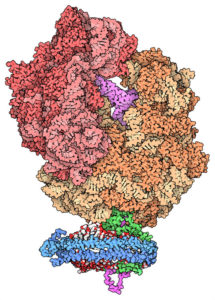
Every month, the Protein Data Bank highlights a specific molecule with a focus on its structure and its function. For the month of September, they are highlighting nanodiscs, which are tiny discs of lipids surrounded by two belt-like proteins. Originally engineered from high-density lipoproteins that mop up cholesterol in the blood, nanodiscs are most often used to study membrane proteins, which can fit inside, one per disc typically. Although widely used, the nanodisc structure is rarely seen. One of the first high-resolution images came from our 2011 paper on visualizing membrane-protein insertion through SecYE, embedded in a nanodisc, during translation by the ribosome, using cryo-electron microscopy and molecular dynamics simulations (see the image at right). Thanks to RCSB for bringing attention to this structure!
SimBac – simulations of bacterial systems
…and other interesting biological phenomena
